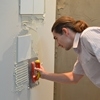If monitoring of cadmium or lead emissions is required, this is carried out in accordance with EN ISO 10545-15 and the value obtained is indicated. The essence of the method is as follows. The glazed surface of a ceramic tile or slab is exposed to a solution of acetic acid and the amount of lead and cadmium passing into the solution is determined using an appropriate method, for example, atomic absorption spectrometry. These metals are sometimes found in glazes and pose a health hazard.
These tests are intended for glazed ceramic tiles and slabs used for installation on work surfaces and walls in food preparation areas where food may come into direct contact with the surface of the glazed ceramic tiles and slabs.
There is 1 Comment
Calculation of released lead Pb and cadmium Cd
In cases where the use of glazed ceramic tiles and slabs requires control of the release of lead or cadmium, for example, in contact with food (kitchen work surfaces, in certain sectors of the food industry), it is produced in accordance with EN ISO 10545-15 c indicating the obtained value.
The specific gravity of lead (Pb) and cadmium (Cd) released from the tested surface, R a (M), mg/dm2, is calculated using the formula
R a (M) = R(M)*V/(1000*A),
where M is the released metal (Pb or Cd);
R(M)—concentration of metal M in the extracted solution, mg/l;
V is the volume of acetic acid, ml;
A is the area of the tested surface, dm2.
- Login to leave comments

